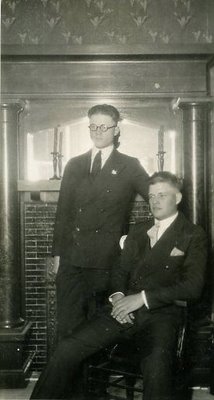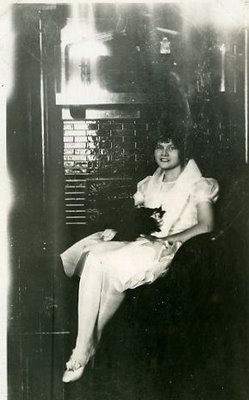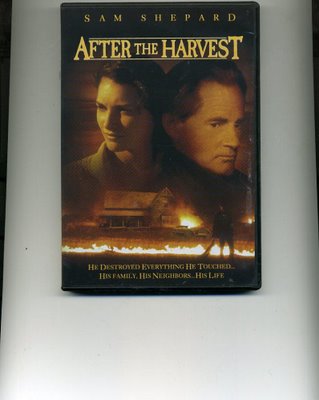

Thanks to the Kovar machinery, the Sam Strachans were at their most prosperous and optimistic point. Then came a 25% tariff on the machinery and the decision to move to Oregon. In the meantime, the Brandon house with the Kovar warehouse behind it was as comfortable as they had ever been. The address was 724 10th Street. There was a “sacred fireplace” that became the new anchor point for ceremonial photographs, and even a “sacred staircase.” The house would be an excellent location for several graduations and a double wedding as the children reached maturity.

Seth and Glenn were formally posed in fall, 1927, just before they left for “flying school” in Marshall, Missouri, in preparation for the acquisition of a small airplane for Kovar business. Seth began his lifework as a pilot in this way.

May is posed in her graduation splendor in June, 1928, dressed almost like a bride with a bouquet on her arm. (She earned a Certificate in Domestic Science from Manitoba Agricultural College.) In those days the fashion was white stockings with white satin shoes -- just as in the Seventies the fashion was black stockings with black patent leather shoes. The fireplace itself appears to be of glazed brick with a fancy enameled grill over the opening, probably intended for coal rather than wood. It seems quite English to my eye. The area above the mantel shows a built-in mirror. Two candlesticks adorn the actual mantel -- at least one can’t see the mantel clock. Maybe it stayed with its bookcase from the previous houses or maybe it just doesn’t show. There is an elaborate columned carpentry surround framing the whole fireplace area. The chair in both photos seems to be an unremarkable wooden chair, borrowed from someplace else. Other photos show the hearth as rubble! Broken rocks and possibly brick. This suggests that the original hearth -- marble? -- was removed for some reason and the pieces were a stopgap.

The stairway is very nice: carved wood, gracefully designed. A radiator shows, meaning that this house has a furnace or boiler which probably means a basement. This, along with a lack of easy chairs for reading near the fire, might suggest that the fireplace wasn’t really used for heat. This would be an excellent stairway for a bride to descend -- or two brides since the Strachan wedding was double. (Unusually good-looking couples, I might add! The brides dressed as May did for graduation except for veils gathered into little upside-down sugar bowls on top of their heads.) I suspect that the frieze at the top of the wall and the window shade were left by the former owner. Also the quite remarkable art nouveau wallpaper in the main room! I wish I knew the colors. I'm guessing turquoise, plum, orange!
The family was quite proud of the fact that this house had belonged to Martha Ostensko, the author of “Wild Geese,” published in 1925 and a great hit. Slyly dedicated to her father, the story is about a prairie patriach in territory more like Minitonas, who in his drive to succeed ruled his family too harshly. There is a terrible prairie fire arising from Caleb’s greed. The passage below comes late in the book after the fire. Lind is the school teacher who boards with the family.
“The first hoar frost came, and Lind woke one morning to find the earth covered with white, powdered glass. The sun took its glitter within a few minutes, but the land was not the same after it had gone. It seemed to have left a shadow over the stubble and over the short brown grass of the pastures to the west, and over the black corpses of the trees that had been ravished by the fire. The days that followed were as full of mellow radiance as those that had gone before, the wind was as soft and the sky as intimate a blue, but there was some change in the mood of the earth.
“Then Lind heard the honking of the first wild goose, high overhead. On a night that was cold with moonlight she heard it, a full, clear trumpeting, in a sky that was vacant of clouds. The wild geese were passing over -- passing over the haunts of man in their remote seeking toward the swamps of the south. They marked the beginning and the end of the period of growth. Next year they would fill the sky with their cold, lonely clamor at sowing time, and again when the earth would have closed in upon itself after yielding its growth.”

In 1996 a movie called “After the Harvest” was made for Canadian television, based on this novel.

Sam Shepard played the patriarch, but he was nothing like Sam Strachan, nor were his children like the trapped siblings in the story. Still, especially in Brandon, there was a sense of them trying their wings, looking to the south. Probably the exception was Elsie, who grew up in Brandon. When she married Glenn, she may have felt that the future of the family would be securely and prosperously in Brandon. In fact, she became a poet and would eventually have her work published in The Saturday Evening Post and Arizona Highways. Most of her adult life would be in Southern California, but she had no inkling of that yet.
Murdock McLean, called “Doc,” met the Strachan sons in Winnipeg at MAC and then their sister May. After a year back home in Reston, Ontario, on his father’s substantial farm -- big house with stone foundation, even bigger and always expanding barn, and a family to match with a patriarch a bit more like Caleb -- he decided to throw in with the Strachans in Brandon. He and May, along with Glenn and Elsie, formed a foursome. In old age, the two widows called each other late at night when rates were low to share their lives and memories, still close as school girls.
In fall of 1929 Bruce, graduated in Winnipeg, left for Oregon State College to get an advanced degree in “scientific agriculture.” Sam and Beulah, facing the economic future of Kovar, bought a house in Portland. May and Doc soon joined them. Glenn and Elsie stayed in Brandon in hopes that Kovar would somehow recover or at least survive. Elsie ran a little beauty parlor in an upstairs bedroom.
You know what happened next: economic depression like a prairie fire: so harsh and widespread that people across the continent died of starvation and suicide. Sam went up to Brandon to help close out the business and move the remains to Portland.
3 comments:
I'm really enjoying this series of essays and photos, but then, since I discovered your weblog a few weeks ago, I've been enjoying all your essays. Thank you for giving me new and interesting things to think about!
Thanks, Rebecca! I've bookmarked your website. As so often happens, if someone likes one's blog, one is likely to enjoy theirs as well. And so we create neighborhoods out of continents!
Prairie Mary
PrarieMary,
I'm Henri Kovar and I have some original Strachan ad copy/catalog and correspondence from the 30's. My Aunt who is now about 88 remembers dealing with the Strachans; She tells me Strachans either precede or followed a party named Jamison as dealers of Kovar in Western Canada. E me @ anchorrode@yahoo.com
Post a Comment